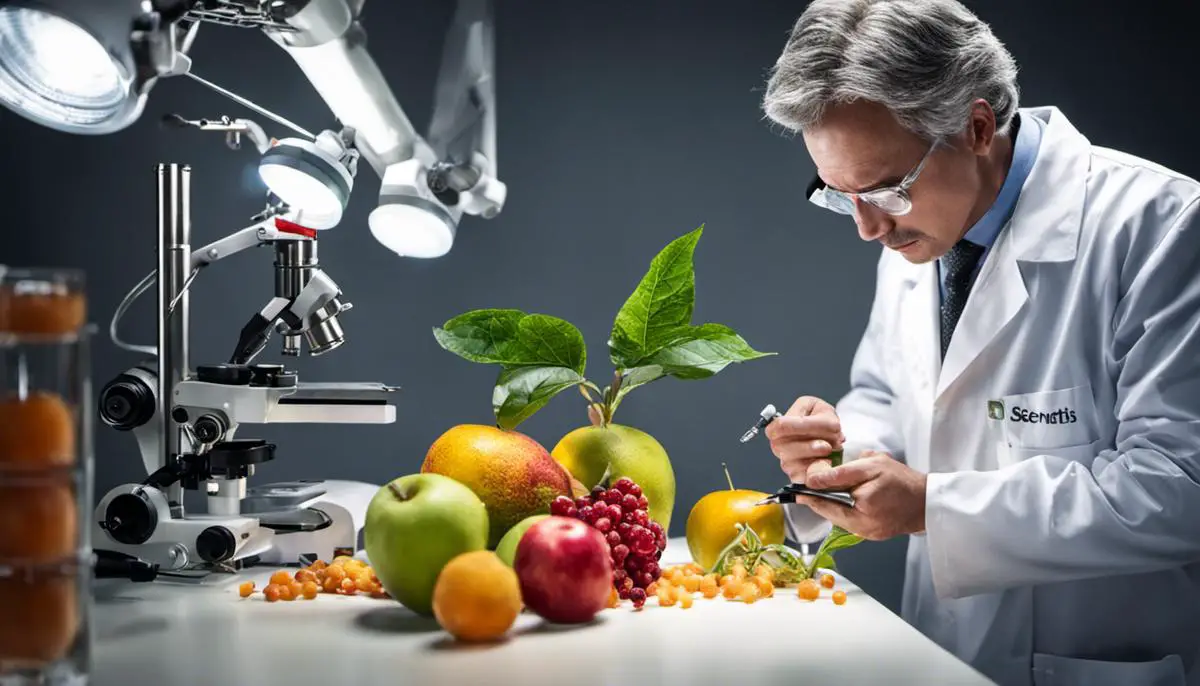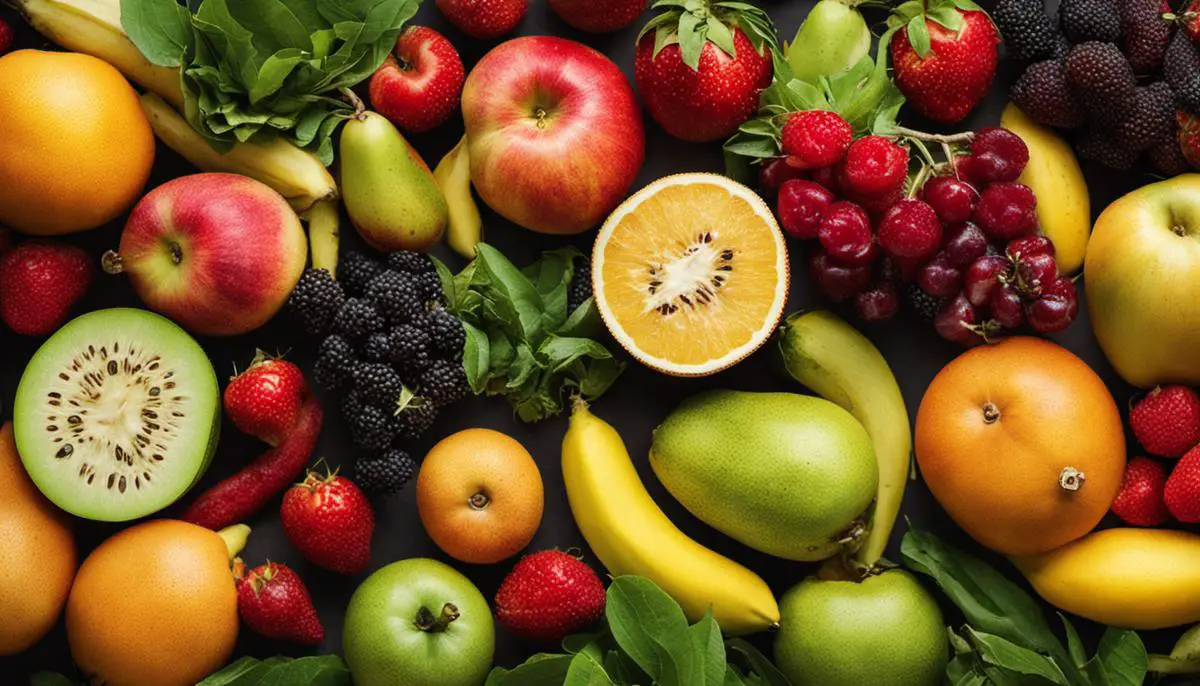
In the modern era, developments in biotechnology have opened up innovative and compelling avenues, prominently in the realm of agriculture. A serpentine invention is the concept of genetically modified organisms (GMOs), a topic that elicits diverse reactions globally. Specifically, this dissertation looks into genetically modified (GM) fruits, a significant facet of the GMO world. This investigation will delve into the basics of GMOs, their development, and their safety and nutritional concerns. Additionally, the focus will extend to the environmental impact GMOs pose and the current state of regulation and labeling of these products. More importantly, it will cast a light on the public’s perception of GMOs and the factors affecting these views.
Understanding GMOs and Their Development
Unraveling the Mystique of Genetically Modified Organisms: The How and Why of GMOs
In the quest to effectively surmount the inexorable challenges threatening global food security, humanity has progressively embraced the power of science and technology. Indeed, one such outcome is Genetically Modified Organisms, often abbreviated as GMOs. A cornerstone of contemporary biotechnology, GMOs hold substantial potential as agents of change in various sectors, particularly in agriculture, where they could help assuage crippling food shortages and debilitating diseases.
Let us delve into the essence of what GMOs are. A genetically modified organism is essentially an organism whose genetic material has been artificially manipulated through genetic engineering. This diverse technology facilitates the transfer of genetic material from one organism to another, creating combinations of plant, animal, bacteria, and virus genes that do not occur in nature or through traditional crossbreeding methods. This cutting-edge genetic aria allows scientists to enhance or modify specific desired traits such as yield, nutritional value, disease resistance, or herbicide tolerance in organisms.
Now, the question arises: How are GMOs developed? The process of producing GMOs is nuanced and incorporates several bioengineering methods. Although early techniques involved transferring an entire DNA sequence into a host, modern practices primarily involve the transference of single genes.
The journey of creating a GMO embarks with the identification of a trait of interest in a donor organism. A simple example might be the Bt trait in bacteria that confer resistance to devastating pests. Once the trait is identified, the gene associated with this trait is located and copied. The process typically involves the extraction of messenger RNA (mRNA) from the cells of an organism and using reverse transcriptase to build complementary DNA (cDNA) sequences.
Once the cDNA sequence is constructed and deemed ready, a vector system is used to incorporate it into the recipient organism. Vectors are essentially vehicles that transport the gene of interest into the organism. The most prevalent vectors are usually plasmids, small circular pieces of DNA that can replicate independently, or bacteriophages, which are bacteria-attacking viruses. Once inside the organism, the vector unloads its precious genetic cargo, which can then integrate into the host genome.
Following the integration, the organism must be allowed to reproduce. It is during this phase that the gene of interest could potentially express itself, manifesting in the desired characteristics. Each offspring from the first generation is then carefully studied, to ascertain if the desired traits are present and stable.
It is paramount to underscore that the translation of a desirable trait from one organism into another is not inherently unsafe. The process of genetic modification is meticulous and subjected to rigorous safety standards, peer-reviewed scientific studies, and regulatory overviews.
In closing, GMOs, developed through the powerful tool of genetic engineering, could pave the way for solutions to some global challenges. From increasing crop yield to enhancing nutritional content and making plants resistant to pests and diseases, genetically modifying organisms may hold an important key to feeding our present and future generations on a warming planet. Yet as with any potent scientific endeavor, proceeding with careful research, comprehensive understanding, and responsible applications is of utmost import.

Safety and Nutritional Concerns
Continuing our scientific exploration of genetically modified organisms (GMOs), let us now specifically delve into the topic of GMO fruits – their safety, and whether or not they are as nutritious as their conventional counterparts.
Numerous research and scientific studies have been devoted to these inquiries, given the prominent place these engineered products have assumed in our global food supply. Hence, it is of immense importance to ensure that genetically engineered fruits neither pose a threat to human health nor degrade the nutritional value integral to the natural counterparts they’re intended to augment or replace.
Regarding the safety of GMO fruits, there has been rigorous and relentless testing conducted by independent bodies and regulatory authorities worldwide. The results have been largely consistent: Current GMOs on the market are safe for consumption. Notable bodies such as the National Academy of Sciences, the World Health Organization, and the American Medical Association stand with this consensus. They affirm that genetically engineered crops are no more risky than conventional (non-GMO) crops.
Critics often speak of potential, unforeseen consequences of genetic engineering. While intellectually valid, it may be stressed that any new food product (genetically engineered or otherwise) may carry potential risks. Consequently, the safety profile of GMOs is continually validated by ongoing research and monitoring after they hit the market.
Turning our gaze towards the nutritional content of GMO fruits, one must understand that genetic engineering, by its nature, alters an organism’s genome. This doesn’t inherently mean a nutritional diminishment. In fact, often one of the aims of genetic engineering is to increase the nutritional value or offer new benefits.
For instance, Golden Rice, a GMO crop, has been engineered to produce beta-carotene (a vitamin A precursor), intending to alleviate vitamin A deficiency prevalent in several parts of the world. Similarly, genetically modified bananas, also known as “super bananas,” have been developed to deliver increased amounts of vitamin A.
Moreover, it’s essential to recognize that genetic engineering has the potential to not only match the nutritional value of traditional fruits but to exceed them. Novel research is in the works to maximize the nutritional potential of fruits using techniques such as incorporating higher protein content, additional vitamins, or more dietary fiber.
In conclusion, while the debate around GMOs continues, the cumulative evidence from multiple scientific studies suggests that GMO fruits are, indeed, safe to consume and can potentially offer enhanced nutritional content. The pursuit of genetic engineering endeavors provides opportunities for addressing global food security and combating nutritional deficiency. This promise is balanced by the necessity for ongoing research, thoughtful implementation, and above all, rigorous and relentless scientific scrutiny for both safety and efficacy. The future of GMO fruits is one of expanding potential and steadfast vigilance.

Environmental Impact of GMOs
Vastly anticlimactic to merely leave the discussion at mere analysis of potential benefits and safety aspects of GMO fruits, it is paramount to probe into its environmental implications as well. To merely behold these matter-of-factly engineered marvels unleashing profound potential without analyzing their ecological ripple effects would be a severe dereliction of duty. Hence, it is in that arena that we turn our microscopic lens and inquisitive disposition.
In the ecological sphere, a pivotal concern associated with GMO fruits is the prospect of horizontal gene transfer – a process wherein genetic material from one organism is incorporated into a nonsexually reproducing, different species. Posing concerns not just regarding human health, but quite rightly so, the health of critical pollinators and other non-target organisms, this precarious role of GMOs underscore their potential environmental risks.
Whilst GMO fruits can undoubtedly be endowed with heightened resistance to pests, the revelation of certain insects developing resistance to the Bacillus thuringiensis toxin expressed in genetically modified crops necessitates vigilant monitoring. Serving as a reminder of the resilience of Mother Nature herself, this potential risk of increased insecticide use to counter resistant pests may, unfortunately, prove detrimental to both the biodiversity and the environment.
However, as we navigate through these potential pitfalls, it would be unwise to overlook the environmental upsides that GMO fruits present. For example, GM crops like Bt cotton or Bt brinjal have showcased a substantial reduction in the usage of chemical insecticides, contributing to a healthier environment and reduced exposure risks to farmers. Similarly, the development of drought-resistant GMO fruits holds enormous potential to adapt to climate change with reduced use of water – a precious resource.
Within the niche of genetic modification, there also exists the promise of mitigating post-harvest losses through traits such as delayed ripening. Manifesting in reduced food waste, such advancements have the potential to lessen the strain on land and water resources, thereby embodying an environmental advantage.
Even as we traverse the labyrinth concerning the environmental impact of GMOs, it remains imperative that the highest degree of ethical and scientific diligence be employed. Public involvement, continued regulation, and rigorous pre- and post-release testing with due consideration to regional biodiversity and eco-systemic balance is absolutely fundamental.
While GMO fruits indisputably represent an extraordinary horizon of opportunities for addressing global nutritional deficiencies and food security, their interaction with Mother Nature’s intricately woven web of life is highly complex. As such, navigating this promising yet precarious path demands a robust ecosystem of research underpinned by a commitment towards socio-ecological responsibility. An epitome of enlightened scientific advancement, GMOs not only draw the curtains open on a world of possibilities but assert the compelling need for exploration guided by meticulous caution.

Photo by foodreich on Unsplash
Regulation and Labeling of GMO Products
Illuminating the Regulatory Path for Genetically Modified Fruits: Compliance, Labeling, and Public Awareness
The regulatory landscape overseeing the production and distribution of Genetically Modified Organisms (GMOs), including fruits, is multifaceted. A combination of federal agencies share regulatory oversight, ensuring that GMO products, before market release, undergo rigorous safety assessments. Currently, the U.S Food and Drug Administration (FDA), Environmental Protection Agency (EPA), and the United States Department of Agriculture (USDA) shoulder this responsibility.
Beginning with the FDA, their principal concern is the safety of food and feed derived from GMO crops. The FDA expects a premarket review of bioengineered foods, requiring developers to demonstrate that the GMO fruit is just as safe as its non-GMO equivalent. It exercises control through its policy of voluntary consultation, where developers reach out pre-market to ensure their GMO fruit does not present food safety risks.
The EPA’s regulatory authority over GMOs derives from the Federal Insecticide, Fungicide, and Rodenticide Act (FIFRA) and the Toxic Substances Control Act (TSCA). The EPA oversees the environmental safety of introducing genetically engineered plants and microorganisms, particularly when they possess pesticide-related traits.
As for the USDA, its Animal and Plant Health Inspection Service (APHIS) administers regulations concerning the introduction (meaning importation, interstate movement, and environmental release) of genetically engineered organisms that may present a risk to plant health, including fruits.
Evolving from regulations to labeling, it is of paramount importance that consumers identify and differentiate between GMO and non-GMO fruit. In 2016, the U.S Congress mandated the creation of a National Bioengineered Food Disclosure Standard. This legislation placed USDA at the helm of establishing a mandatory standard for disclosing whether a food has been bioengineered. As of January 2022, this standard has been implemented, which means all GMO foods—including fruits—now require an appropriate label indicating their GMO status.
The label could be in the form of a text, symbol, electronic or digital link, and/or text message. Importantly, exemptions exist if the food is served in a restaurant or similar retail establishment, or if it contains bioengineered substances that are indistinguishable from their non-engineered counterparts using validated testing methods.
Amidst an esoteric matrix of regulations and labels, public awareness and understanding are essential. Consequently, an ongoing thrust is towards bridging the knowledge gap between scientific nuances of GMOs and public understanding. Structured educational programs, symposia, and open forums are tools leveraged to increase public literacy about GMO fruits.
In closing, while the journey of GMO fruits from the lab to the market is complex and meticulously regulated, it still represents the leading edge of a broader conversation on food security, environmental conservation, and global health in a rapidly changing world. This underlines the need for dynamic regulations that are regularly updated to accommodate new scientific findings, advancements, and societal needs.

Public Perception of GMOs
The public response to genetically modified organism (GMO) fruits is multifarious and intricate. People’s attitudes towards this scientific innovation are shaped by a gamut of factors ranging from personal beliefs, understanding of the technology, perceived benefits and risks, trust in regulatory bodies, and societal norms.
A key factor shaping public perception is the understanding or misunderstanding of what GMOs are. Despite efforts from scientific and regulatory bodies to increase public literacy, misconceptions about GMOs persist. Many erroneously believe GMOs are unnatural, harmful, and inordinately increase pesticide use, which fosters skepticism and resistance.
Furthermore, an inability to differentiate between various types of genetic modifications, confusing gene editing with transgenics, for instance, may elicit greater apprehension. Unfounded fears, often propagated by sensationalist media coverage and misinformation online, have further fueled public antipathy towards GMOs.
However, there is a segment of the public that appreciates the potential of GMOs. They recognize that the ability to introduce desired traits – such as disease resistance or enhanced nutritional value – could have significant benefits for food security and nutrition, especially in a world grappling with climate change, burgeoning population, and malnutrition. Notably, Golden Rice, a GMO variety fortified with Vitamin A, has caught public attention as a potential solution for vitamin A deficiency in developing countries.
Trust in regulatory bodies is another determining factor in public perception. People who have confidence in the oversight provided by entities like the FDA, EPA, and USDA are more likely to accept GMO fruits. These agencies are tasked with scrutinizing GMOs for safety and environmental concerns before they are released into the market. Existing regulations necessitate the rigorous testing of GMOs, ensuring they are safe for consumption and the environment.
Conversely, those mistrustful of these institutions have a heightened skepticism towards GMOs, often fueled by perceived conflicts of interest, questions on transparency, and fears about the influence of biotech companies in the regulatory process.
Labels indicating a product contains GMOs have been posited as a transparency measure, allowing consumers to make informed choices. However, mandatory GMO labeling has had unintended consequences: it has instilled a sense of danger or unhealthiness in some consumers, who perceive the label as a warning. Invariably, this affects public acceptance negatively.
Lastly, the exigencies of the present, forged by a changing climate and rising global food demand, are gradually reshaping public perception. GMO fruits that can withstand harsh environmental conditions or have enhanced nutritional content are being viewed more favorably as solutions to these global challenges.
In conclusion, the public reaction to GMO fruits is shaped by their knowledge and understanding, trust in regulatory bodies, perception of benefits and risks, societal influences, and the present global context. Addressing the knowledge gap through effective science communication, upholding trust in regulatory processes, and highlighting the potential benefits of GMO fruits in addressing pressing global needs could foster greater public acceptance of this scientific advancement.

As we forge ahead into the future, the role of genetically modified fruits is undeniably going to grow more pronounced. Navigating this rapidly evolving landscape mandates informed decisions, facilitated by acquiring an all-encompassing understanding, from their development to their implications. Scientific knowledge, environmental implications, governing policies, and public sentiment all play essential roles in shaping this journey. The widespread acceptance of GMO fruits largely hinges on the transparency of their making and effects, ensuring safety precautions, and considerable respect towards public misgivings and expectations. In turn, a progressive outlook that embraces the merits of GMO fruits without dismissing their potential downsides can ideally lead to realizing their full potential.



